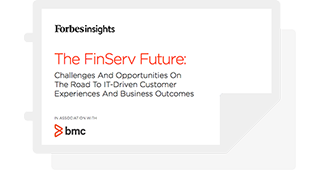The pace of digital innovation is accelerating for the financial services sector, and it’s imperative to have the human resources to help drive that innovation forward. The FinServ Future, a new Forbes Insights and BMC survey of 300 U.S.-based C-level executives at financial services firms, found that a top concern is having the right talent who are capable of bridging existing tech capabilities and disruptive technologies designed for the future.
Among C-suite executives at firms with revenue below $1 billion, 27 percent say hiring and retaining talent is most important for their organization over the next three years. At larger organizations, it’s 34 percent. In a 2019 study, McKinsey found that digital roles accounted for just 7 percent of total US bank staff and 15 percent at digital-forward banks, so there’s some work to do.
It’s an issue that affects the way your business runs, the experiences of your customers, and whether you make your growth targets. There’s more than one path to finding the right people. It can be done through new hires, reskilling and upskilling current staff, and turning to an ecosystem of contractors and contingent workers.
First, it’s important to recognize that today’s tech professionals are eager to dive into work that’s exciting, hands-on, and results-oriented, encompassing technologies and practices such as:
- Automation
- Neural networks
- AI and machine learning
- Agile development
- Product management
- User experience design
- Data science
- Digital marketing analytics
Be irresistible to new hires
Jamie Warder, head of digital for KeyBank, recommends empowering staff beyond traditional, mundane tasks, telling Forbes Insights, “[They] want to ship product, create interesting things, [and] feel like they’re doing something above and beyond just writing code day-to-day.”
Within that arena, established institutions often have an edge over start-ups, despite their glamorous allure. “It can be just as attractive to have the stability of…a larger organization that has a huge customer base, history, [and] a clear market share,” Jeremy Balkin, head of innovation and strategic digital partnerships at HSBC Bank USA, explains to Forbes Insights.
TIAA’s in-house incubator is one successful example from the Forbes Insights study. “Technology people…want to build, support, [and] design great things,” says Scott Blandford, the chief digital officer and head of technology at TIAA Financial Solutions. “I create an environment where they can be creative [and] deliver things that actually ship to customers. [With] just a handful of people [and] hardly any budget, [we’re] building startups in 45 days, but with the resources of a big company.”
Leverage the inside track
Another way to cultivate the best talent is to grow it from the inside. According to a recent Deloitte study, future finance leaders need to be able to balance business knowledge with tech fluency. Starting with employees who are fully embedded in the inner workings of the industry, but perhaps not as up to speed on the digital world, presents an excellent opportunity to leverage institutional knowledge and expand a skillset.
That echoes a BDO study where financial firms acknowledged that current employees need resources, training, and development to be effective as their roles evolve. Seventy-three percent cited a lack of skills or insufficient training as the biggest challenge to moving forward with a new digital initiative.
Staff by project
A third possible solution, and way to stay ahead of the curve, is to work collaboratively with contractors, contingent workers, joint ventures, and independent talent. PWC suggested in a survey last fall that they’re often the best equipped to jump right in on the newest technologies.
The financial services industry’s turn toward digital transformation begins with staff who can nimbly navigate it—whether it’s new hires, current/retrained talent, or a collective of niche IT professionals with specialized skills. For more information on the talent question and other issues at the forefront of the digital evolution, check out The FinServ Future.
The FinServ Future: Challenges And Opportunities On The Road To IT-Driven Customer Experiences And Business Outcomes
These postings are my own and do not necessarily represent BMC's position, strategies, or opinion.
See an error or have a suggestion? Please let us know by emailing [email protected].







